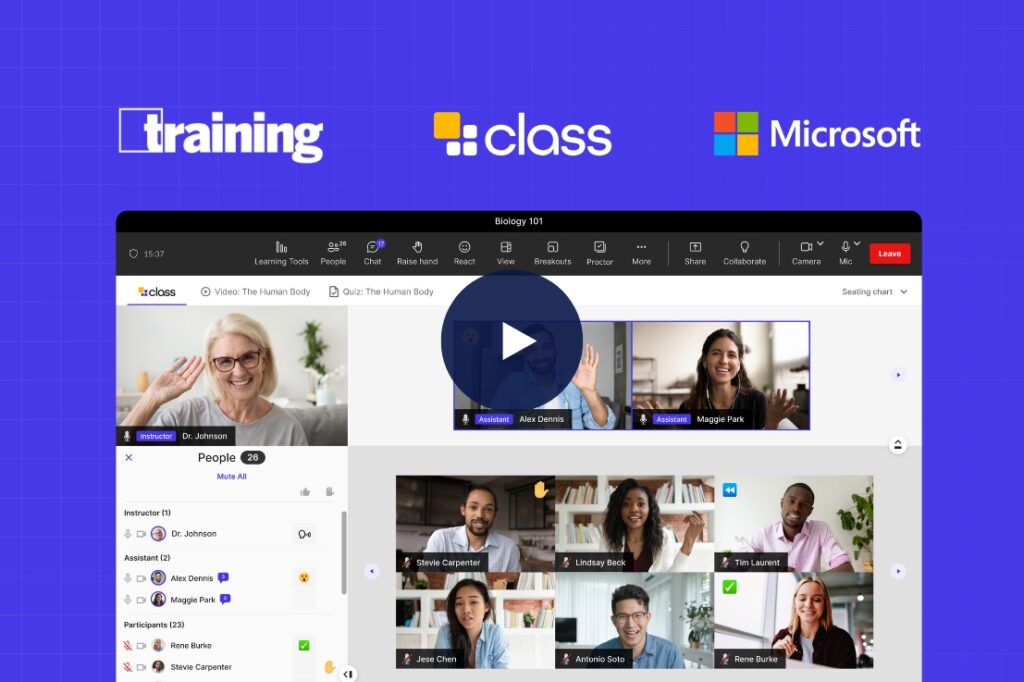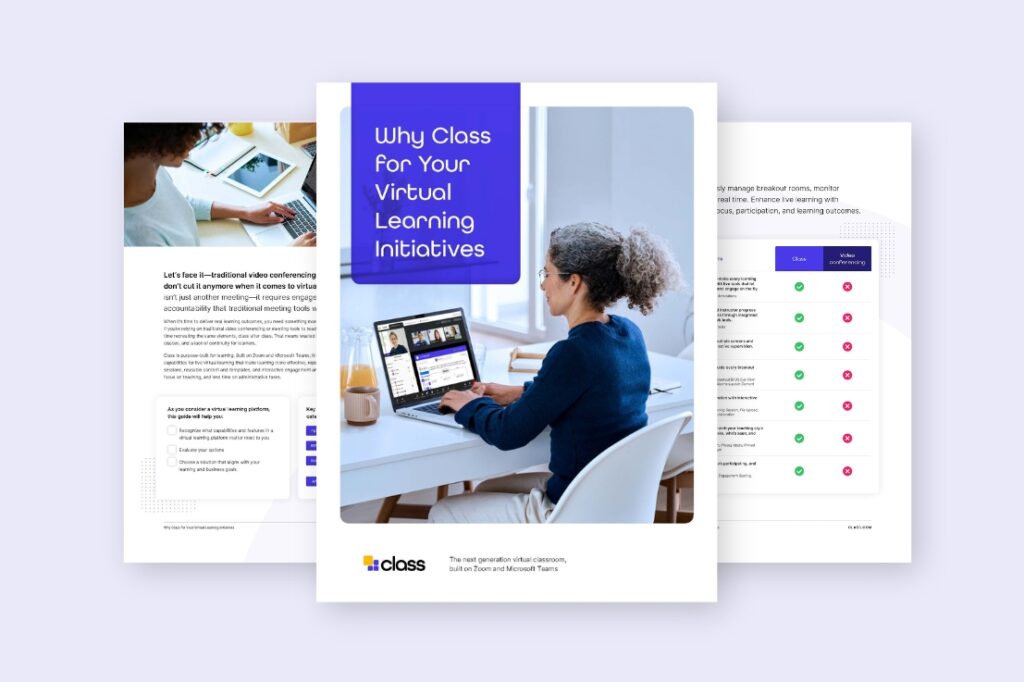As the innovative pace of edtech continues to surge forward, many within the industry are asking, “What is the future of online learning?” New technologies, as well as heightened investments, have opened doors within education—specifically within synchronous online learning.
Recently, Michael Chasen, Class Co-Founder and CEO, spoke with Alexander Sarlin from the Edtech Insiders podcast to discuss the question, “What is the future of education?” with a more specific focus on synchronous online learning. That conversation prompted this deeper look into the future of edtech, including how technology has changed to allow for virtual classrooms to reflect more of the benefits seen in traditional classrooms, what features are setting the stage for the future of online learning, and what new features are around the corner for the industry.
How synchronous online learning has evolved
One of the limitations of online education in the past was that virtual classrooms didn’t really exist. Web conferencing tools couldn’t create the same space as a physical classroom. Additionally, functionalities for simple day-to-day actions of traditional classrooms like taking attendance or giving out quizzes were cumbersome and time-intensive. Because these actions couldn’t be easily replicated online, virtual learning felt secondary to in-person education.
With improvements to the technology and new functionalities available—created directly from educators’ feedback—virtual classroom platforms have been able to go beyond stop-gap tools to intentional software, such as elevating from the limitations of screen shares to highly engaging, interactive media sharing.
Chasen provides an excellent example of this, noting, “We heard from a lot of teachers, ‘Hey, breakout rooms are great. We use them every day, but the problem is, when I send my students to breakout groups, I can’t see what’s going on in the different groups if I’m not in it.’ We added an ‘All Breakout Room’ view. So, teachers can actually see what’s going on in every breakout room at the same time.”
Chasen adds, “And they can see which students are participating, who’s talking, who’s not paying attention. And then they can go ahead and send content to the different breakout groups. They can say, ‘Hey, I want Breakout Group #1 to do this assignment, I want Breakout Group #2 to take this quiz, I want Breakout Group #3 to explore this website. And so, all the things that teachers used to do to keep it engaging, to make it interactive with the students and the physical classroom, that on Zoom you were just limited to a screen share, we made interactive.”
The features setting the stage for the future of synchronous online learning
When thinking about the question, “What is the future of edtech?” it’s important to consider the features setting the stage for the next evolution in the field. Advances in integrations are a notable factor.
Chasen lays out the demand with the example of live components connected to Learning Management Systems (LMSs), “So, institutions that have an LMS, they want to have a live component […] We plug right into those LMSs. So now, you could go into your Blackboard or your D2L or your Open LMS or your Canvas…And the teacher might be saying, ‘Hey, 7:00 this evening, we have a live class, click here’ and it launches Class for that synchronous component.”
“And we fully synchronize with your LMS. So, the class roster is automatically there. Attendance is automatically transferred. You can launch all of your LMS content in Class,” adds Chasen. “And you can say, ‘Hey, we’re going to take a quiz right now.’ It’ll launch that Blackboard quiz right within Class, let them take it, the grade goes right into the gradebook. So, it’s really exciting, we really bring a lot of that LMS content into the live synchronous environment.”
Additionally, AI for learning continues to expand opportunities for educators and learners alike. Chasen notes how Class is leveraging artificial intelligence to provide an AI Teaching Assistant that students can access live during synchronous online learning. The applications are extensive, including enabling those who arrive late to catch up on what they’ve missed, allowing learners to perform deep dives into lesson material past what is being discussed in the class, and even aiding students who are at risk of falling behind by allowing them to get additional details without the potential embarrassment of raising their hand or requesting the instructor slow down.
Sarlin notes of AI Teaching Assistant, “[It] feels like a very natural extension, and one that could have enormous impact on what a class looks like.”
Synchronous online learning trends of the next few years
There are a few major trends emerging in edtech that will play a pivotal role in the industry over the next couple of years. First is the skyrocketing interest in adopting and utilizing online learning as part of learners’ curriculums. With demand continuing to increase across the field, especially within higher education, leveraging this technology and the innovations that are evolving is crucial for districts and institutions.
Second is the reality that online learning can now not only replicate and enhance the physical classroom but also provide abilities and access to data that previously hadn’t been possible. Hybrid learning models, virtual classroom demand from students, and an embrace of the flexibility and access inherent to a mix of in-person and online learning look to be an important factor at this stage.
Finally, a seismic shift is looming with AI’s ability to customize learning, provide additional resources, help lower costs, and increase access. This on top of the ability to leverage AI to find previously disparate data points and make next-level connections sets up an exciting next couple of years.
Better access, better environments, and better outcomes
The future of synchronous online learning will build on the impressive strides of the past few years. Continuing to find organic ways to utilize current innovations with evolving tools and technology is at the heart of this process—creating better learning environments, improving learner outcomes, and developing more access for students.
Interested in exploring the future of edtech with a team at its forefront? Let’s chat! At Class, we’re passionate about using technology to improve the education experience for all involved.






